Elevating apricots
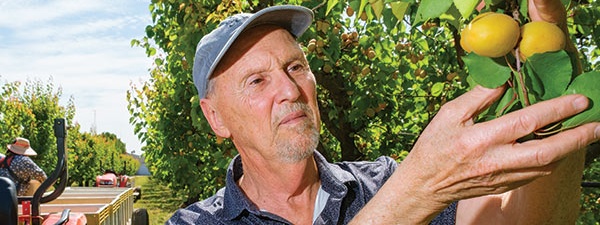
Spring 2025 California Bountiful magazine
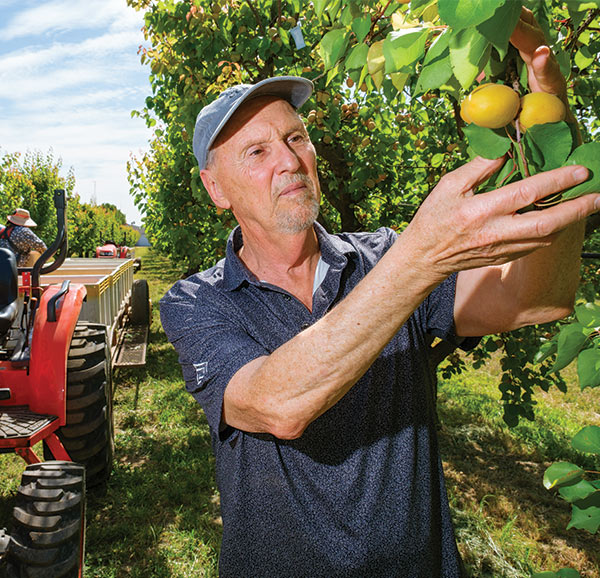
Fresh and preserved, the stone fruit delivers sweet flavor year-round
Story by Ching Lee
Photos by Steve German
Biting into an apricot can be a sensory powerhouse. Velvety soft to the touch, the golf ball-sized fruit is sweet and tangy with notes of honey, and when picked at peak ripeness, its fruity yet slightly floral scent can be intoxicating.
Having grown his share of apricots since the early 1970s, Dave Santos acknowledges not all apricot varieties have been winners, and some of the ones grown back in the day simply tasted bland.
“There was a joke that you could eat the apricot and chew on the box, and they would have about the same flavor,” he recalls.
Much has changed, says the co-owner of Lucich Santos Farms and Blossom Hill Packing in Patterson, a region known as the “apricot capital of the world.” His farm has worked with nurseries and plant breeders for years to test new varieties of the stone fruit, and he says some of the current ones on the market are much improved.
“Today, we’re working on fruit that tastes good,” he says, including varieties that mature well, have high sugar levels and are “something that the consumer will want to buy and come back and buy again.”
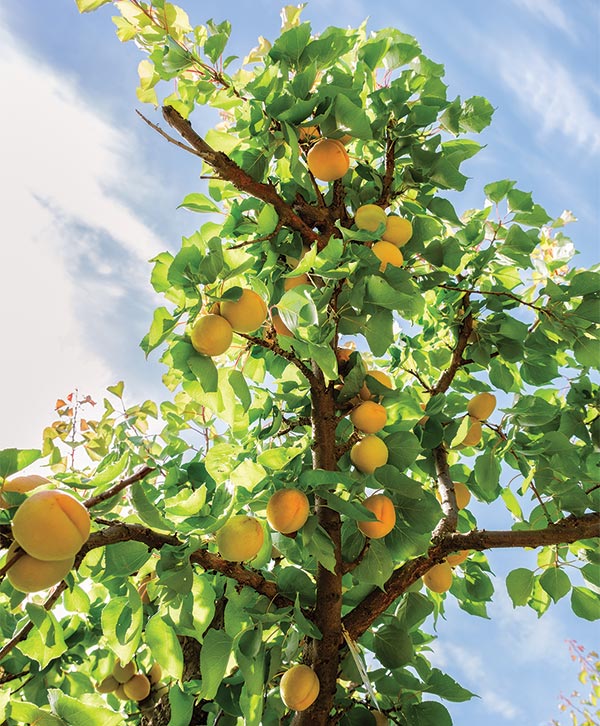
A delicate challenge
As a fresh fruit, the apricot’s fragile nature and short shelf life have long been its Achilles’ heel. That’s why most of the state’s crop has traditionally been used for processing, because when apricots are canned, dried or frozen, they can be picked ripe with their high sugar and flavor preserved.
“It’s very difficult to get a ripe apricot to the store that’s got good flavor and still have it look visually appealing,” says Stanislaus County grower Daniel Bays, who serves as president of Apricot Producers of California and whose family has been farming apricots since the 1960s.
Because apricots are so delicate, they must be picked by hand—which is costly and labor-intensive—though some processors allow machine-harvested fruit if it’s used to make juice, for example. Longtime grower Stan Lester of Yolo County says even if harvest can be done by machine, which he says “doesn’t do a super great job,” the trees still must be pruned by hand every year.
He removed his apricot orchard about two years ago after he sold his bakery, which served as a key outlet for his apricots.
“We used to cut and dry a lot of them and sell them at our bakery,” Lester says. “That used to be a big market of ours. We’d have people coming from all over trying our apricot pies.”
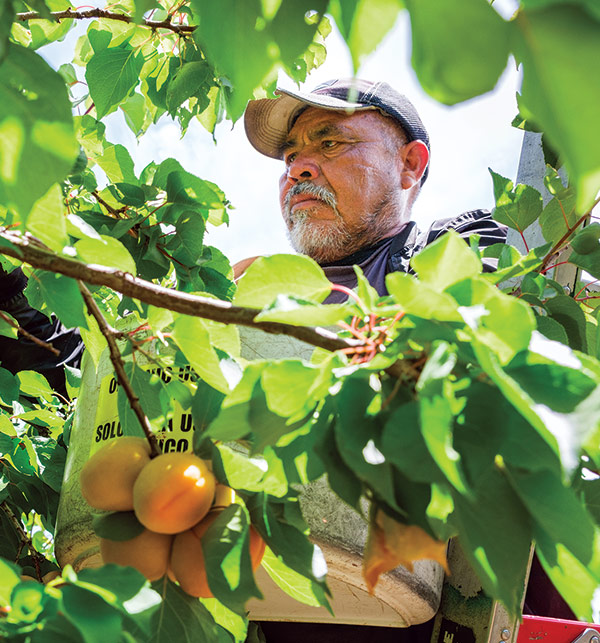
Changing markets
Even with challenges of the crop, major inroads have been made elevating apricots as a fresh fruit. Whereas only 8% to 16% of the state’s crop went to the fresh market in the 1980s, the share of fruit going to the fresh market versus processing is more evenly split today.
Santos’ business has been part of this shift. His farm used to send 90% to 98% of its apricots to processing. But as people’s diets and preferences changed and canneries disappeared, “we were some of the people that got left out, not having a home for our apricots,” he says. He and his business partner, Pete Lucich, decided to start packing their own fruit, eventually building a small packing shed in 1978.
That business continues to grow, Santos says, these days packing 250,000 to 300,000 boxes of conventional apricots and some 100,000 boxes of organic apricots annually. The farm grows 14 varieties of apricots, including apriums—apricot-plum hybrids—with 70% of the fruit destined for fresh eating. The rest is shipped to Del Monte, Pacific Coast Producers and Del Mar Food Products for canning and freezing.
As one of the first stone fruits to hit the market each spring, fresh apricots have a fleeting season: They’re available for about six weeks, most of it ripening in late June to July, though harvest can begin as early as late May. Some varieties allow farmers to pick as early as late April to the first week of May.
The Patterson variety—named for the town at the heart of apricot production—continues to be the most widely grown, as it can be sold fresh but is ideal for canning, freezing, juicing and drying.

Fresh or canned
Despite growing demand for fresh apricots and rising consumer interest in locally grown produce, the state’s apricot acreage has diminished through the years. California growers harvested 5,300 acres of apricots in 2023 compared to more than 15,000 acres in 2003. Even so, the Golden State remains the largest apricot producer in the nation.
Much of the downward trend in production has to do with the waning popularity of canned fruit. Domestic dry yards also took less fruit beginning in the late 1980s and 1990s, as they were squeezed by the influx of less expensive imports, particularly from Turkey, the world’s top apricot producer.
“By the time you get to the grocery store, the California dried apricot is almost twice the price what a Turkish or Mediterranean apricot would cost,” Bays says.
There has been some resurgence, he says, as people realize the quality of California apricots and seek out the domestic product. The boost in demand for canned fruit during the COVID pandemic also helped, Santos says, with shoppers rediscovering the product. Bays says the industry is trying to do a better job of reminding consumers that they can enjoy the flavors and nutritional benefits of apricots year-round in the canned, frozen or dried form.
To that end, producers have started a social media campaign with recipes and videos on how to use canned apricots. The collection features baked goods such as apricot pie pockets, upside-down cake and cobbler, and main dishes such as apricot glazed chicken.
Want to make a refreshing smoothie with three ingredients? Chill a can of apricots in juice and then blend with one frozen banana and a cup of Greek yogurt. Only one ingredient is needed to make apricot sorbet: Freeze a can of apricots, run the can under hot water to loosen, cut the contents into chunks and puree in a food processor.
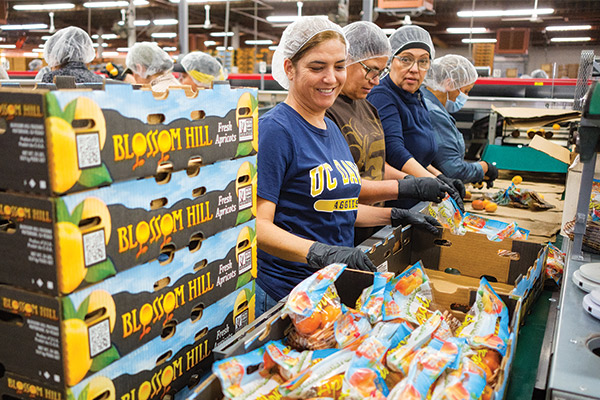
Farm stand appeal
This time of year, when apricots are in season, it would be worth it to seek out the fresh version of the fruit.
Jason Bremmer, who grows five different varieties of apricots in Colusa County, sells his fruit only when it’s ripe—the way it’s meant to be eaten, he says. That requires his employees to pick a tree five to seven times, as not all the fruit ripens at once.
Bremmer markets most of his crop directly from his farm stand, which opens for about 25 days during harvest season. He estimates he sells about 1,500 boxes of fresh apricots this way, with some of it going to a local school district and two stores. The farm stand also sells apricot pies, jams and dried apricots produced by the farm.
People know about his farm through word of mouth, with farm stand customers coming from as far away as Los Angeles, Oregon and Washington state. They load up on fresh apricots to make their own jams and preserves or to eat them fresh. One local customer buys boxes of them for drying and then gives them away as Christmas presents, Bremmer says.
“We have people drive in and out of our place even when apricots aren’t ready because they want apricots,” he says, “and they continue to come every year.”

